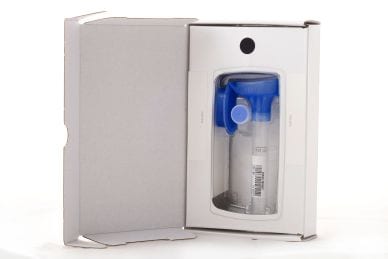
The way our Personal Genome Serviceâ„¢ works is pretty straightforward, at least from a customer’s point of view. We send you a saliva collection kit, which is at its heart a plastic tube. You spit in the tube and send it to our laboratory, which extracts DNA from your saliva, analyzes it and deposits the resulting genetic data in your account.
Though the process usually goes off without a hitch, each sample has to clear a number of quality control hurdles in order to be processed. If it doesn’t, a customer’s data may take a little longer than expected.
Sample problems can almost always be corrected one way or another. It is only in very rare cases that a person’s saliva contains so little DNA that repeated efforts to analyze it fail (In those situations, we do provide a refund!).
For those of you who really want to know all the messy details, below is a detailed account of what can go wrong with a sample, and what we do if it does:
Step One: The Visual Exam
Samples arrive at our lab every day. The first thing technicians do with each new sample is scan the barcode on it, because that’s the only identifying information the laboratory has. For privacy reasons, the customer’s name and other account information never passes beyond the 23andMe firewall.
As soon as the samples have been scanned, they undergo their first test – a visual inspection to make sure they contain fluid up to the “fill line” on the side of the tube. Occasionally samples do not pass, either because they leaked in transit or the preservative solution (buffer) isn’t released into the tube when the customer snaps the oblong cap onto the collection funnel. Either way, if a sample tube doesn’t contain enough liquid we immediately contact the customer and ship a free replacement kit so he or she can spit again.
Step Two: DNA Extraction
If a sample passes visual inspection, it’s time for DNA extraction. The process our laboratory uses to isolate and purify the DNA in your saliva is simply an automated version of the same one you can do at home that allows technicians to process batches of 96 samples. Technicians remove a portion of the saliva from each tube, then put the rest of the sample aside so they can try again in case their first attempt fails. If a second attempt to extract DNA from a particular sample fails as well, we send a second kit to the customer who provided it (free of charge) so that person can provide a fresh (and hopefully DNA-rich) one.
A sample may lack enough DNA for extraction if the preservative solution is not released when the customer snaps the cap onto the funnel during the collection process. A sample could also contain an insufficient amount of DNA simply because there are not enough cells floating around in it. Some people seem to have less DNA in their spit, though almost everyone has enough for the purposes of our analysis.
Step Three: Genotyping
Samples that yield sufficient quantities of DNA are submitted for genotyping, which scans the genetic material at the approximately 580,000 markers (SNPs) included in our service. This process is also performed in batches of 96 samples. And once again, we monitor the process to make sure it is going as expected. If it isn’t, we try again. In this case a sample is re-run if the analysis process cannot determine its genotype at a minimum of 98.5% of the locations we probe (roughly 570,000 out of the 580,000). If the second attempt fails as well … we ship the customer another sample collection kit for free.
Once a sample has been successfully analyzed, the laboratory sends the resulting data to 23andMe along with the barcode that came with the sample. That allows our database to deposit the information in the proper account and send an automated email notification to the customer who holds it.
With all the things that can go wrong, the sample analysis process may seem a little precarious. But it’s actually quite robust – the vast majority of samples sail right through without a hitch. If things do go smoothly, we can generally return data within eight to 10 weeks of the date a sample is sent to the lab.
My name is Varsha Baichwal and I work here at 23andMe as Director of Operations. You can share your genome with me if you wish — my 23andMe ID is “varsha”.